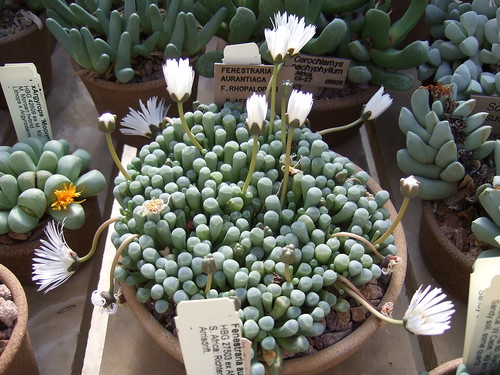If there was a competition for cutest succulent, I know which one I would vote for.
Its common name might be a little strange, but it’s easily explained: this succulent’s leaves do look slightly like little baby digits. This weird and wonderful specimen from Southern Africa is a great addition to your succulent collection; just don’t forget to follow its care guidelines or it might not live a long life.
Keep reading for everything you need to know about growing baby toes (Fenestraria rhopalophylla).
| Name(s) (common, scientific) | Baby toes, babies’ toes, window plant, Fenestraria rhopalophylla |
| Difficulty level | Hard |
| Recommended lighting | Bright indirect |
| Water | Lightly during winter |
| Soil type | Coarse and gritty |
Did you know? There is only one recognized species in the genus Fenestraria: Fenestraria rhopalophylla. This means it’s currently a monotypic genus. However, Fenestraria rhopalophylla Aurantiaca, a subspecies, is a candidate for being classified as its own member within the genus.
Baby toes succulent care
When trying to figure out Fenestraria care, it’s important to keep in mind this plant’s natural habitat and growth pattern. Fenestraria naturally occurs in Namaqualand, which covers parts of Namibia and South Africa. Namaqualand is mostly dry and desert-like, with hot summers, cold winters and little rainfall.
This succulent has adapted to its harsh habitat by developing the ability to grow partly underground. Its little digit-like leaves have translucent tops, which are sometimes the only parts of the plant sticking out of the ground. Because light can travel through the tops, the plant can still photosynthesize even when mostly covered.

Baby toes succulent light, location & temperature
Light
So, as discussed above, Fenestraria is very efficient at making the most of the light it gets. This means it can do well in a pretty wide range of light levels. It can take quite a bit of direct sun as long as it’s not getting absolutely blasted outdoors, but bright indirect light should also work.
In your home, place this succulent near a window (or under a grow light) that allows plenty of light to reach it.
Location
Because Fenestraria isn’t used to receiving a lot of water or growing in moist soil, a relatively dry environment is probably preferred.
Try finding a spot on your home that’s well-ventilated and not too humid.
Temperature
As can be expected from a versatile plant like this one, Fenestraria can take a very wide range of temperatures. It has no problem with summer heat but is also tolerant to light frost.
Do keep in mind that this succulent should be kept dry when temperatures get very low to prevent frost damage.

Planting baby toes succulent
Like most succulents, Fenestraria doesn’t react well to being in moist soil for prolonged periods of time. In fact, it’s even more sensitive to rot than most of its cousins and absolutely can’t handle wet soil.
To prevent issues with rot, plant your baby toes in coarse, well-draining soil. It seems many hobbyists actually prefer a potting soil-less type that contains only gritty material; an example would be this mixture.
As with other plants that love dry soil, the container you plant your Fenestraria in should always have a drainage hole. Terracotta pots allow moisture to drain easily, so they make a great choice for plants like these. You can find more information in the article about planting succulents.

Watering baby toes succulent
Watering mistakes are probably the primary cause of death for most succulents, and this is no different for Fenestraria. In fact, it’s probably worse.
This succulent is notoriously picky about when it wishes to be watered. This can be pretty confusing, but it helps to keep in mind that this is not a summer grower. Unlike many other plants it spends its summers in dormancy, as it’s too hot and dry in its natural habitat to keep growing during this period.
Once springtime is over and the heat pushes your Fenestraria into dormancy, stop watering. Maybe give a very light sprinkle here and there, but nothing more or rot will set in.
During the autumn, spring and especially winter months, your Fenestraria is active and wants to be watered. Wait until the soil has fully dried, then soak it thoroughly and let it dry again.

How to propagate baby toes
If you’d like to propagate your baby toes succulent, you’ll be happy to know that it’s an absolute breeze. This is a clustering plant, so all you have to do to make more baby toes is to divide the mother plant.
Propagating baby toes is best done when you’re repotting the plant. Just separate clusters with a few leaves each and pot them up separately. They’ll all continue growing as usual.
Buying baby toes succulent
Although it’s definitely not the most common succulent out there, you should be able to find Fenestraria with a little effort.
If you have a local succulent nursery nearby you might find it there; otherwise, keep a close eye on your favorite plant store’s stock or order online from one of the many sellers.
Tip: Love the look of this funky window succulent? Don’t forget to check out fairy elephant’s feet, a similarly whimsical species, as well.

Are baby toes succulents toxic to cats and dogs?
Sources are actually not consistent on this. A few sources report that Fenestraria varieties can be toxic or even ‘very toxic’ to animals and humans. Multiple other sites list it as safe.
I’d say it’s probably safe, but since you don’t want your pets munching on your plants anyway, you might want to place this one in a place that’s hard to reach.
Cover photo: Fenestraria Flowering by faroutflora (CC BY-NC-ND 2.0)





